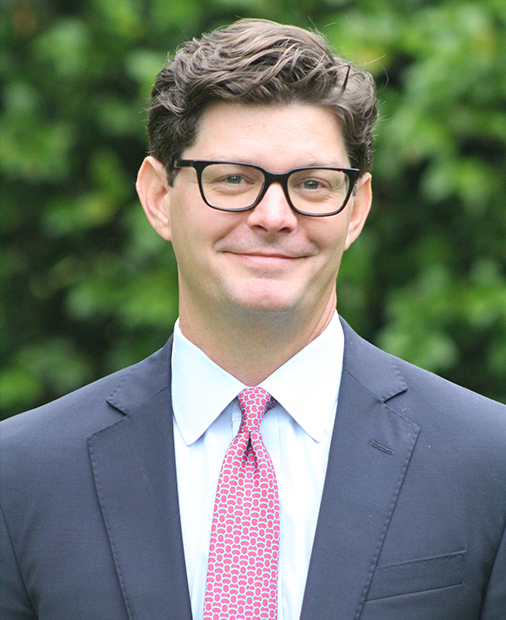Online Trademark Attorneys
Trademark Attorney Working With Clients in New York City, NY
If you're an entrepreneur, you know that protecting your intellectual property should be high on your list when it comes to safeguarding your company. However, as a successful business owner, you also know the steps and costs of filing a trademark in the U.S. can be expensive and arduous.
This conundrum can be even more overwhelming for new business owners who want to do everything possible to minimize the price of securing trademarks. They try to handle complicated tasks like trademark registration on their own, which can be a big mistake - especially when juggling the day-to-day tasks of running a business. You may be thinking, "But what about those set-it-and-forget-it services you can find online? All you have to do is plug in your info, and you're done." Using pre-made templates for trademark filing can be tempting, but doing so can leave you with inadequate protection and hurt you in the long run.
So, what is the easiest, most cost-effective route to consider that also minimizes legal risk? The truth is, before you spend money on an online filing service, it's best to consult with a trademark attorney working with clients in New York City, NY.
At Sausser Summers, PC, our experienced trademark attorneys can help you understand the trademark process step by step. We can even help with U.S. trademark filing, U.S. trademark responses, and U.S. trademark renewals at a price you can actually afford. That way, you can make an informed decision regarding your business without having to break the bank.
Sausser Summers, PC: Simplifying the U.S. Trademark Process
Hiring an attorney can be a daunting task, but at Sausser Summers, PC, our goal is to make the process as simple and seamless as possible for you. That's why we offer a straightforward checkout service. First, you choose your flat fee trademark service and fill out a short questionnaire. Then, we will contact you within 24 hours to discuss the details of our service. From there, one of our experienced trademark attorneys will get to work on your behalf.
Using a trademark attorney for filing in New York City, NY, can significantly increase your chances of a successful registration. The U.S. government recommends hiring a trademark attorney to help with your application, and our team of trademark lawyers is dedicated to meeting your needs. In fact, we help ensure your application is filed correctly the first time so you can get on with your life and avoid legal risks.
At Sausser Summers, PC, we work closely with our clients to understand their needs and provide them with sound professional advice. We never offer incomplete services, such as simply filing for registration, because that would leave you open to legal risks. You can rely on us to handle your intellectual property matters, and our flat fee services can help protect your business in a simple, straightforward, and affordable way. It's really that simple.
In terms of filing a U.S. trademark, we provide an easy three-step process to protect your intellectual property:
1. You provide your trademark info to our team via an online form.
2. Our team performs a comprehensive trademark search. This search ensures that no other marks will prevent you from registering your trademark in the U.S. Once performed, we'll send you a legal opinion letter that details our findings.
3. Sausser Summers, PC, files your U.S. trademark application. We are then listed as your Attorney of Record on file. From there, we'll provide ongoing updates regarding the status of your trademark as it works through the registration process.
The bottom line? At Sausser Summers, PC, we give both new and seasoned business owners an easy, efficient, cost-effective way to protect the one asset that sets them apart from others: their name.

The bottom line?
At Sausser Summers, PC, we give both new and seasoned business owners an easy, efficient, cost-effective way to protect the one asset that sets them apart from others: their name.
Do I Really Need a Trademark Attorney for Protecting My Business in New York City, NY?
It's not necessary to be a lawyer in order to apply for a trademark. Anyone can submit a trademark application to the U.S. Patent and Trademark Office (USPTO). However, registering a trademark involves more than just filling out a form. It's essential to conduct thorough research, accurately identify and clearly explain your trademark to ensure it receives adequate protection. And even after securing a trademark, you've got to monitor it consistently to make sure it's free from infringement.
The big takeaway here is that it's always a good idea to work with a trademark attorney to protect the intellectual property that you've worked so hard to establish. According to the Wall Street Journal, applicants are approximately 50% more likely to secure their trademark than people who file applications on their own. If your trademark application is rejected by the USPTO, you will need to revise and refile it, incurring additional filing fees. To avoid delays and extra costs, it is best to have a trademark lawyer help you get it right the first time.
Additional Benefits of Using a Trademark Attorney
Great trademark attorneys (like those you'll find at Sausser Summers, PC) will help with every step of filing and enforcing your trademark. Some additional benefits include the following:
Check to see if your proposed trademark is registered by another entity.
Conduct research to see if another business is using the trademark for which you're applying.
Provide advice and guidance on the strength of your trademark.
Draft and submit your trademark applications and application revisions.
Advice and guidance regarding trademark maintenance and protection.
Monitor the market for unauthorized use of your trademark.
Trademark enforcement to protect you against infringement.

Curious whether our trademark attorney services are right for you and your business? Contact Sausser Summer, PC, today. Let's talk about what you need, and how we can help.
What About Online Filing Services?
Online services, can provide you with basic assistance in filing your trademark. However, they will never be a legitimate substitute for an experienced trademark attorney helping clients in New York City, NY.

Although online filing services offer a step-by-step process, they take a one-size-fits-all approach to preparing legal documents. Even their advanced service only provides basic attorney assistance in completing your paperwork and helping with minor roadblocks. Online filing services' disclaimer highlights the many limitations of its services, including the fact that communications are not protected by attorney-client privilege. In addition, online filing services cannot provide advice, explanations, opinions, recommendations, or any kind of legal guidance on possible legal rights, remedies, defenses, options, selection of forms or strategies.
In other words, online filing services can offer you the necessary forms and point you in the right direction, but they cannot customize their services to your specific needs or help you with serious complications that may arise.
For the most comprehensive trademark service and protection, it's always wise to work with highly rated trademark lawyers, like you'll find at Sausser Summers, PC.
Understanding Trademarks Over Time
Trademarks in the U.S. can last indefinitely, but did you know that clients in New York City, NY can file a trademark online, only to lose protection in some circumstances? Trademarks differ from patents and copyrights in that they do not have an expiration date. However, to prevent the cancellation of a trademark, you must maintain it. To ensure that your trademark remains protected, you must actively use it in commerce and renew it with the USPTO every ten years.
The Lanham Act tells us that "use in commerce" is the legitimate use of a trademark in the ordinary course of trade. In other words, you cannot register a trademark solely to reserve the rights to it in the future. In most cases, a trademark must be used continuously in connection with the goods or services it is registered for.

Steps to Renew Your Trademark
Trademarks are registered with the USPTO and generally need to be renewed every ten years. However, there is one crucial exception that you should be aware of. Within the first ten years of owning a trademark, you must file for renewal between the fifth and sixth year from the date of your initial registration.
During this renewal period, you are required to submit a Section 8 declaration, a specimen that shows how the mark is being used, and pay the required fee. You can also apply for Section 15 Incontestability status, which can strengthen your trademark rights. This application, although not mandatory, can make it harder for others to challenge your ownership of the mark.
After the first renewal, which falls between the fifth and sixth year of ownership, the next renewal filing is due between the ninth and tenth year, and then every tenth year thereafter. In the ninth year you will need to file a Section 8 declaration, attesting to your use of the mark or excusable nonuse. You've also got to file a Section 9 renewal application before the end of the tenth year to keep your registration active.
It is worth noting that the USPTO provides a six-month grace period if you fail to renew your mark within the required time frame, but it is best not to rely on it. If you don't file within the grace period time limits, the USPTO will cancel and expire your mark.
By hiring trademark attorneys helping clients in New York City, NY, you can avoid the pitfalls and mistakes that can arise and cause you to lose your rights to the mark that represents it.
Losing Your Trademark Rights Through Abandonment
In the event that you stop using your trademark and have no plans to resume using it in commerce, it may be considered abandoned by the USPTO. This could result in the loss of your protective rights to the mark. Typically, a trademark is assumed to be abandoned if it has not been used for three years. However, you may be able to refute this presumption by providing evidence that you intend to use the mark again in the future.
Losing Your Trademark Rights Through Inappropriate Licensing
In addition to trademark abandonment, you should also be wary of improper licensing. It's important to remember that once you allow someone else to use your trademark, you must keep an eye on how they use it. You should monitor the products or services that feature your trademark to ensure that they meet consumers' expectations in terms of quality. Failure to do so can lead to a "naked" trademark license and the loss of your protective trademark rights.
How to Avoid Having to Refile Your Trademark
If you're wondering how you can avoid refiling your trademark, the answer is simple: file it correctly the first time around. Filing a trademark isn't inherently difficult, but when doing so, it's very important that certain aspects are filled out accurately in your application. If any information is missing or incorrect, the trademark application may be considered "void ab initio" or void from the beginning, requiring you to file again.
To avoid this, make sure that the information you provide in the application is accurate and complete, including the ownership of the trademark. For instance, if a corporation has multiple shareholders, it should not file under the President's personal name. The rightful owner should be the one/entity that ultimately controls the trademark and the associated goods/services.
It is also important to ensure that the goods and/or services description is precise. For example, if you sell electronic products, you should not file for research and development services despite having a research and development department. The goods/services description should reflect the goods/services you offer to customers, not the departments within your business.
Additionally, providing accurate dates of first use when filing for a trademark is crucial. The USPTO requires two dates to be specified - the date of first use anywhere and the date of first use in interstate commerce. Contact our trademark law office today to learn more about having accurate dates on your filing paperwork.


What Makes an Online Trademark Attorney Great?
At Sausser Summers, PC, we often get questions about how to distinguish run-of-the-mill consultants and others from great trademark attorneys. After all - when you're looking for an attorney to file or prosecute your business trademark, you should know their qualifications. Here are three ways you can separate the proverbial wheat from the chaff when it comes to trademark attorneys.
It's crucial to seek legal advice from a licensed trademark lawyer rather than relying on advice from non-professionals like trademark consultants. The USPTO even recommends hiring an attorney to help with the trademark process. Although trademark consultants may provide advice on trademark availability or name marketability, they cannot file the trademark for you or offer legal advice. According to the Rules of Practicing in trademark cases, "Individuals who are not attorneys are not recognized to practice before the Office in trademark matters." This rule applies to individuals who assist trademark applicants.
When searching for a trademark attorney, it's important to find someone with a strong background in trademark law. Look for an attorney who specializes in this area and has significant experience handling trademark-related cases. Avoid lawyers who don't have expertise in this field, as they may not be able to provide the guidance and support you need.
Ensure your attorney provides updates throughout the trademark registration process to avoid missing deadlines, including responding to any Office actions within six months. Failure to do so can result in trademark abandonment. The USPTO will only correspond with the listed attorney of record, so make sure your attorney keeps you informed.
In summary:
- Be sure you're using a licensed trademark attorney helping clients in New York City, NY.
- It's best to work with a trademark lawyer who has years of experience filing trademarks.
- Ensure that your trademark lawyer is willing to provide ongoing notifications relating to your trademark application process.

Trademark Attorneys Working Hard for You
Building your brand and gaining recognition for it is a significant achievement, and it's important to protect it. However, there are certain pitfalls and mistakes that can arise, causing you to lose your rights to the mark that represents it. By working with knowledgeable trademark attorneys, you can avoid these issues and file your trademark successfully.
With an A+ rating from the Better Business Bureau (BBB), Sausser Summers, PC, offers comprehensive guidance, strategic advice, and reliable representation for a variety of trademark matters. Our attorneys have years of real-world experience and, having registered countless trademarks with the USPTO, provide our clients with individualized representation when they need it most.
If you're looking for skilled, adept, and experienced counsel, look no further than our trademark law firm. Contact us today to schedule your initial consultation and learn how we can help you safeguard your brand.
Latest News in New York City, NY
Guy Fieri’s New Times Square Restaurant Launches With a Sputter
Luke Fortneyhttps://ny.eater.com/2025/2/4/24358401/guy-fieri-chicken-guy-times-square-review
II have to imagine November 2012 was an interesting time for Guy Fieri. A week after Barack Obama was re-elected to office, Fieri’s Times Square restaurant, Guy’s American Kitchen & Bar, was panned by Pete Wells, the former New York Times food critic, in one of his most famous no-star ratings. The review was so brutal, we studied it in my college jou...
II have to imagine November 2012 was an interesting time for Guy Fieri. A week after Barack Obama was re-elected to office, Fieri’s Times Square restaurant, Guy’s American Kitchen & Bar, was panned by Pete Wells, the former New York Times food critic, in one of his most famous no-star ratings. The review was so brutal, we studied it in my college journalism courses. Fieri must have learned something, too.
In 2017, Guy’s American Kitchen & Bar closed. Aside from a short-lived ghost kitchen, Fieri hadn’t tried opening another restaurant in New York City — until this month.
Over the weekend, Fieri returned to Times Square with Chicken Guy!, a fried chicken chain he has been expanding across the country (138 W. 42nd Street, between Broadway and Sixth Avenue). It’s a big moment for the brand: Of the 25 locations that are open or coming soon, this is the first in New York City. The original Chicken Guy! opened in 2018 at the Walt Disney World Resort in Florida.
The scene: Times Square, of course, has changed since Fieri was there last. The neighborhood has become the epicenter of fast-casual fried chicken, with new locations of the Filipino brand Jollibee, Chick-fil-A, Raising Cane’s, and Birdbox, the offshoot of a Michelin-starred restaurant in San Francisco. That might explain why the crowds were thin on opening day at Chicken Guy!.
The Fieri spot was deserted an hour after doors opened at 11 a.m. on January 31. There were a couple of people seated toward the back of the restaurant, past the open kitchen and next to the Jumbotron playing reruns of Diners, Drive-ins, and Dives, but otherwise, the dining room was empty.
One of the best parts of visiting any fried chicken chain is the sensory overload: the stench of grease traps mixed with floor cleaner that smacks you when you walk through the door, and the sounds of diners crunching fried skin at nearby tables. So, when I waited for my order in odorless silence, I figured that I was in for it.
The chicken verdict: How was the fried chicken? Not that good. The chicken is shaped into cutlets and cooked in a pressure cooker, not a deep fryer. I’m sure that approach works elsewhere, but at Chicken Guy!, the pressurized chicken is dry and hard to get down, as if the Cinnamon Challenge was mixed with Donkey Sauce. The overcooked ends had the consistency of rock candy.
The original sandwich ($13 with fries and a drink) is a standard job that comes with two tenders, pickles, and a garlicky sauce. There are several variations available, but I’m not convinced that adding Buffalo macaroni and cheese or bourbon-brown sugar barbecue sauce can save it. For a better version of that exact dish, I’d head to any other chain in the neighborhood.
The fried chicken dumplings ($9 for five) were far worse, and don’t be fooled by the name — it’s the dumpling that’s fried, not the chicken inside. The breaded wrapper had an acceptable texture, but it was impossible to get past the taste because of the bacon bits and teriyaki sauce that were ladled over the top.
If you must go: Some of the non-chicken dishes were more successful. The chopped cheese egg rolls ($7) have potential; if you dust off the salt, you’re looking at a stoner substitution for the excellent cheesesteak egg rolls at P.J. Clarke’s. I didn’t mind the sludge-like texture of the apple cinnamon cereal shake ($7), either, given the generous, well-distributed pieces of Cinnamon Toast Crunch and Apple Jacks.
The (lack of) Fieri factor: Then again, no one is visiting Chicken Guy! for milkshakes: We want Fieri! And not the one on the flatscreen television at the back, the one who filmed 51 seasons — more than 500 episodes — of Diners, Drive-ins, and Dives.
I figured if there was ever a time he would make another appearance in Times Square, it would be at the grand opening of his comeback restaurant.
But no, last weekend, he was at a California Chicken Guy! in Hollywood.
NYC Is in Store for an LA-Level Housing Loss Calamity in Floods, Report Predicts
Samantha Maldonadohttps://www.thecity.nyc/2025/02/04/flood-housing-destroyed-nyc/
New York City could lose up to 19,300 homes in the next 15 years due to flooding from high tides and storms — more than the toll of 2012’s Hurricane Sandy — estimates a forthcoming report by the Regional Plan Association.Another 24,300 units within the five boroughs could be substantially damaged by 2040 in a major storm that has a 1% chance of happening in any given year. The region encompassing Westchester and Long Island could lose tens of thousands more units of housing by then.The grim projections convey ...
New York City could lose up to 19,300 homes in the next 15 years due to flooding from high tides and storms — more than the toll of 2012’s Hurricane Sandy — estimates a forthcoming report by the Regional Plan Association.
Another 24,300 units within the five boroughs could be substantially damaged by 2040 in a major storm that has a 1% chance of happening in any given year. The region encompassing Westchester and Long Island could lose tens of thousands more units of housing by then.
The grim projections convey how climate change could exacerbate New York’s already dire housing crisis, with reverberations well beyond the most urban areas.
RPA’s research, shared in advance with THE CITY, comes as Los Angeles County experiences a climate change-fueled shock that has exacerbated its housing crisis, thanks to fires that destroyed over 16,000 homes, schools, houses of worship, businesses and other buildings — displacing thousands of Californians and leading to a sudden surge in rents.
The fires and their aftermath present a cautionary tale for New York, where the threat to houses and apartments is inundation from floods, which are poised to become more frequent and severe from climate change.
“It’s our version of what’s happening now in L.A.,” said Eric Sanderson, vice president for urban conservation at the New York Botanical Garden’s Center for Conservation and Restoration Ecology. “They have the fire, we have flooding.”
The New York region has already gotten a taste of destruction from coastal flooding and its impact beyond municipal borders. Sandy destroyed or damaged about 100,000 homes on Long Island, and damaged nearly 70,000 units of housing in New York City, with about 20% made uninhabitable. Future destruction from storms and flooding is projected to be worse.
“We’re going to experience both a gradual ramping up and a couple of shocks,” said Moses Gates, vice president for housing and neighborhood planning at RPA. “We’re going to have Sandy-type events that are going to leave a lot of homes uninhabitable all at once, and we’re going to see a lot of people without other options trying to find housing.”
Liz Koslov, an urban planning and sustainability professor at UCLA who is writing a book about Staten Island residents who didn’t want to move back to their ravaged neighborhoods post-Sandy, said destruction of housing can make worse “forms of precariousness that are ongoing.” (Koslov had to evacuate from the fires with her family.)
“Homelessness and housing insecurity are really normalized as part of the cities we live in, and the forces that produced those experiences are sped up and visible right now,” she said, adding that public investment to support people in their everyday lives and in the event of disasters could mean mass displacement doesn’t have to be an inevitability.
Empty Lots Endure
The Queens neighborhoods of the Rockaways and Broad Channel contain the most housing at risk in the five boroughs, according to RPA’s research, followed by waterfront neighborhoods in Queens and Brooklyn — including Howard Beach, Hamilton Beach, South Ozone Park, Bergen Beach, Canarsie and Flatlands. Many of those neighborhoods already contend with regular flooding from high tides, made higher by sea level rise.
Sea levels around New York City have already risen about a foot since 1900, a higher rate than the global average, and they’re projected to rise more: between one and two feet by the 2050s, according to the New York City Panel on Climate Change. Higher seas mean worse storm surges and more frequent flooding during high tides.
Higher seas also fuel more powerful — and devastating — coastal storms.
After Hurricane Sandy, many homes were rebuilt — some as they were, others made more flood-resistant or elevated — while others were abandoned or demolished.
Housing loss from storms and flooding is already clear in parts of Edgemere, Queens, a neighborhood sandwiched between Jamaica Bay and the Atlantic Ocean on the Rockaway Peninsula. Fences line the perimeter of numerous empty lots, overgrown with brown grasses, where dilapidated houses used to stand. Some homeowners took offers for buyouts from the city after Sandy.
A few homes still remain boarded up and abandoned.
“The houses that you do see that way, that was pretty much the conditions that a lot of them were left in,” said Nykole Slay, a renter who lives on a block in the neighborhood with several empty lots and a few vacant homes.
Slay, 47, said the high tide flooding doesn’t bother her, and that the peaceful environment and unparalleled sunrises make the risks worth it. Full-on destruction of her home would be the only thing to get her to consider moving, she said: “That’s what it’d have to be, because I love my house.”
Basement Apartments at Risk
Multiple flood-protection projects along the city’s coastline are completed or in the works, from flood walls and berms, to raised streets and improved drainage. The RPA’s housing loss projections did not factor in the impact such sea walls and other projects could have — nor did it include housing at risk of damage or destruction from stormwater flooding, like the kind from the remnants of Hurricane Ida in 2021.
Ida caused $7.5 billion in damage across the state and affected about 33,500 buildings in New York City. On top of that, over 100 families remained homeless for more than a year as they struggled to find permanent housing they could afford.
Over 4,000 basement apartments, typically home to lower-income renters, could be vulnerable to major flooding, according to a study by the New York Federal Reserve Bank.
Heading off the housing-market shocks of such calamities would require building a lot more residences in and around New York City, said Marcel Negret, the RPA’s director of land use. He pointed to previous RPA research that found a lack of adequate housing growth could hike housing prices 25% and cause an additional 260,000 families to have excessively high rent burdens.
“All those metrics that are cited there would be made worse by exacerbated impacts from climate,” he said.
Egg-flation sends New Yorkers scrambling for the best prices — and it’s leading them to one supermarket chain
Jack Morphethttps://nypost.com/2025/02/04/us-news/egg-flation-leaves-nyc-eateries-scrambling-i-cant-keep-this-up/
Egg-flation is getting the Big Apple scrambled.The price of eggs is so clucking ridiculous that New York City’s food carts, bodegas and delis are charging more for the iconic — and usually affordable — bacon, egg and cheese sandwich.Cafe Manhattan in Midtown put up signs last week declaring all egg sandwiches will have a 50-cent surcharge — and its manager Gin Yun told The Post he still can’t make ends meet because he’s shelling out four times more than just a few months ago to buy cartons....
Egg-flation is getting the Big Apple scrambled.
The price of eggs is so clucking ridiculous that New York City’s food carts, bodegas and delis are charging more for the iconic — and usually affordable — bacon, egg and cheese sandwich.
Cafe Manhattan in Midtown put up signs last week declaring all egg sandwiches will have a 50-cent surcharge — and its manager Gin Yun told The Post he still can’t make ends meet because he’s shelling out four times more than just a few months ago to buy cartons.
“Oh my God, the price of eggs has gone crazy,” Yun said. “I can’t keep this up, I’m serious. I haven’t made profit for the last two months.
“Four months ago, 30 dozen eggs cost less than $50. Now, 30 dozen eggs cost me $227.”
Maria Chuqui, 36, a cook at the Mexican Food and Breakfast food cart at West 77th Street and Broadway, had a similar tale of egg woe.
She said two months ago a box of roughly 240 eggs cost $90. The same box now costs $217.
“I have never paid so much for eggs,” Chuqui said.
“People don’t want to pay more for eggs, but I will have to raise prices soon,” she said. “I sell an egg and cheese for $4 and an egg, bacon and cheese for $5. I will have to raise prices by $1.”
The shell shock is the result of a bird flu outbreak that’s forcing farmers to slaughter millions of chickens every month — a precautionary measure against the disease that has driven egg prices to more than double their cost in summer 2023.
The national average price for a dozen eggs reached $4.15 in December, approaching the previous record of $4.82 set two years prior — and the US Department of Agriculture forecast that prices could increase 20% this year.
The egg-flation has forced New York Attorney General Letitia James to warn businesses against price gouging.
“Eggs are an essential grocery staple in households across the state, and New Yorkers should not pay ludicrous amounts just to feed their families,” James said in a statement.
Everyday New Yorkers are cracking under the egg price pressure, even before any gouging — and not just for their beloved BECs.
They’re flocking to far-flung grocery stores selling cheap cartons, such as the Bryant Park Whole Foods, where the consensus is they’ve got the cheapest eggs in town.
Flushing resident Mohammad Khan stopped in at the Bryant Park Whole Foods on his way home from work just to take advantage of its prices, which were as low as $4.69 for a dozen.
“It’s $9.99 for a dozen eggs in Flushing,” he told The Post.
“At other supermarkets like Food Bazaar, a dozen eggs is $8,” another shopper said. “I came to Whole Foods just for the eggs.”
A Whole Foods shopper from Jersey City stopped in for eggs because her local supermarket was all out over the weekend.
“Eggs were out of stock at the supermarket in Target in Jersey City this past weekend,” she said. “Whole Foods prices have stayed the same. $5 is a decent price for organic.”
The egg-travaganza at Whole Foods, however, is forcing the store to start rationing eggs.
“We are currently experiencing difficulty sourcing eggs that meet our strict animal welfare standard. For now, we’re limiting purchases to 3 cartons per customer,” a sign taped to the store’s door informed customers.
Bodega owners and their customers — who are generally lower-income than Whole Foods shoppers — are also having a rotten time with the high egg prices.
“Some bodegas are even considering selling eggs by the egg,” said Fernando Mateo, who heads the United Bodegas of America.
Mateo said most bodega owners know their communities can’t afford the skyrocketing costs.
“They feel that this is affecting the poor and not the rich,” he said.
Still, the group is encouraging bodega owners to be good eggs and not raise prices, Mateo said.
“It’s social responsibility, that’s what it boils down to,” he said.
NYC winter storm: Ice, snow, sleet could create 'hazardous' travel later this week
Michael Stallonehttps://www.fox5ny.com/news/nyc-weather-ice-winter-snow-storm-forecast-ny-nj-ct
The BriefA developing winter storm is expected to bring a mix of freezing rain, snow, sleet and ice to New York City, making for a potential slippery and slick Thursday morning commute.Ice storm this week: TimelineTimeline:Computer forecast models are coming into agreement that the storm will develop across the Plains on Wednesday before gaining str...
The Brief
A developing winter storm is expected to bring a mix of freezing rain, snow, sleet and ice to New York City, making for a potential slippery and slick Thursday morning commute.
Ice storm this week: Timeline
Timeline:
Computer forecast models are coming into agreement that the storm will develop across the Plains on Wednesday before gaining strength as it sweeps east across the U.S.
As the system moves off to the east, a strong southerly jet stream will kick in, pulling in warm, moisture-rich air across the eastern half of the nation. That setup will then lead to the development of a warm front, separating subfreezing air to the north from record-breaking warmth to the south.
Local perspective:
The issue is that the warm air will move in above a shallow layer of subfreezing air near the ground. The said that will lead to a large swath of impactful freezing rain that will fall across the region.
According to the from the NYC area northward, the cold air will be deep enough that snow will be a concern during the onset of the winter weather. Cities like the Big Apple could see snow fall during the middle of the Thursday morning commute.
That could wreak havoc on the roads, but the said warm air will move in, changing the snow to either freezing rain or plain rain. Any snow left behind will nearly completely melt.
How much snow are we getting on Thursday?
By the numbers:
Mike Woods predicts around 1-3" inches of snow for most of the NYC area, North Jersey and all of Connecticut.
Eastern portions of Long Island, as well as central and South Jersey, will mostly likely see between a coating and 1" of snow.
What they're saying:
"Precipitation entering an area spanning from the Midwest to the northern Mid-Atlantic is anticipated to mostly fall as a mix of freezing rain and sleet beginning on Wednesday and lingering through Thursday," the NOAA NWS Weather Prediction Center said in a post on Facebook.
What we don't know:
"Forecast remains highly uncertain in regards to exact precipitation types and expected amounts," NWS Mount Holly said in a post on X. "Expected impacts may change with coming updates."
Weekend storm?
What's next:
The system will quickly exit by Thursday, leaving mainly dry conditions in its wake on Thursday night and Friday. However, another winter storm could impact many of these same areas over the weekend.
FOX Weather LIVE updates
NYC weather radar
Click HERE for more information.
The Source
A New ‘Paquita’ Is an Echo Chamber of Ballet History
Elizabeth Kendallhttps://www.nytimes.com/2025/02/04/arts/dance/ratmansky-paquita-new-york-city-ballet.html
New York City Ballet dancers trickled onstage in mismatched sweatshirts, down vests, practice tutus and leg warmers at the start of a rehearsal for Alexei Ratmansky’s “Paquita.” They disappeared, then reappeared in sleek leotards and tights, crisscrossing the stage to mazurka-like music. Soon the whole coalesced in a great diagonal stretching downstage to upstage, headed by a haughty ballerina and her cavalier. Quirky New Yorkers had found the majesty of imperial St. Petersburg.“Paquita,” which has its ...
New York City Ballet dancers trickled onstage in mismatched sweatshirts, down vests, practice tutus and leg warmers at the start of a rehearsal for Alexei Ratmansky’s “Paquita.” They disappeared, then reappeared in sleek leotards and tights, crisscrossing the stage to mazurka-like music. Soon the whole coalesced in a great diagonal stretching downstage to upstage, headed by a haughty ballerina and her cavalier. Quirky New Yorkers had found the majesty of imperial St. Petersburg.
“Paquita,” which has its debut on Feb. 6, offers a sort of echo-chamber that allows 19th-century Russian classical ballet to coexist — to resonate — with today’s City Ballet dancers.
Ratmansky has paired two pieces of Marius Petipa’s 1881 ballet classic “Paquita”: George Balanchine’s 1951 restaging of a first-act Pas de Trois, followed by Ratmansky’s own restaging of the grandiose last act (the Grand Pas Classique). So: Petipa through the lens of Balanchine, then Petipa through the lens of Ratmansky, both further refracted through these young dancers and their ways of inhabiting the steps.
“It’s like a collider, where opposing forces come together,” Ratmansky, 57, said in an interview. He offered another metaphor. Through working on Petipa, he said: “I started to understand this Japanese cake. Crêpes over crepes, this texture of ballet.” All the layers colliding in a new taste.
Both Ratmansky and Balanchine — New York City Ballet’s founding choreographer — grew up with the heritage of Petipa, the Franco-Russian genius who worked at the Imperial Ballet in St. Petersburg from 1847 to 1903. Both trained in something like the style from Petipa’s era, though for Ratmansky it was Sovietized; both absorbed versions of the Petipa classics (“The Sleeping Beauty,” “Swan Lake,” “Raymonda”) into their bodies. And both left the Russian sphere as young dancer-choreographers, then went on to make their art more relevant — even revelatory — for new times and new places.
But Ratmansky, born in 1968, is two generations farther removed from Petipa than Balanchine, who was born in 1904. Balanchine tweaked, twisted, subverted, sped up, syncopated and enhanced Petipa’s steps and Petipa-era training methods, doing it all seemingly organically. Ratmansky, even in the midst of a distinguished career as a modern ballet choreographer, has felt compelled to return to Petipa in a more literal way.
“For me, Sergeyev’s notations are the base,” Ratmansky said. The notations — a ballet’s moves, gestures and formations written down in complex symbols and musical staffs — were brought out of Russia in 1919 by Nikolai Sergeyev, the Imperial Ballet’s chief rehearsal director, and ended up, after a complicated journey, in the Houghton Library at Harvard.
“If you’re digging down into ballet history as an archaeologist,” Ratmansky said of the notations, “you’re getting to the high point of classicism in ballet.” And Ratmansky’s done that for 10 years, restaging, on different companies, many of the old ballets in something like their original form. Some of these, including a lavish “Sleeping Beauty,” were for American Ballet Theater, where he was artist in residence for 13 years.
But since 2023 he has been New York City Ballet’s artist in residence. After creating “Solitude” (2023) for the company, a grieving meditation about Russia’s war in Ukraine, he’s chosen to restage a classic (or part of one) on these dancers whose Petipa heritage through Balanchine is sometimes masked by the modernist rigors of Balanchine-style dancing.
Why this ballet now? “I’ve always enjoyed doing something different at City Ballet from what I’ve done before,” he said, and a new “Paquita” couldn’t be more different from “Solitude” or the six other ballets he’s made for the company over the past 20 years. And the Grand Pas showcases a philosophy, as Ratmansky called it, shared by Petipa and Balanchine, centered on the ballerina. “He doesn’t just admire her,” Ratmansky said, meaning Petipa, “he gives her space to be an artist.” He could just as well have meant Balanchine.
It’s not just one ballerina front and center in “Paquita.” There are four other featured women who have fiendishly complex solo variations, which Petipa insisted should be danced by principal dancers. “The ballerina is placed next to them,” Ratmansky said. “She must outshine them.”
Another inspiration for Ratmansky has been Balanchine’s free-form treatment of the “Paquita” Pas de Trois. “It’s like a modern composer taking an older theme and transforming it,” Ratmansky said. That and his own deepening experience with Petipa have allowed him, this time around, to play faster and looser with the notations. One can see it in the surprisingly interactive tone of the “Paquita” rehearsals.
“How do you feel?” Ratmansky asked Mira Nadon and Joseph Gordon as they worked out a partnering moment in a studio rehearsal. “Maybe I’m too far forward,” Gordon conceded.
“What do you want?” Ratmansky asked Unity Phelan, when, in her variation, she’d asked if he preferred a certain passé — an outstretched leg bending toward the other knee — high or low. She chose the high.
Often Ratmansky would abandon words to show the steps. Suddenly this unassuming, middle-aged man was skimming across the floor as if on a cushion of air, as if merging his own classical virtuosity with that of the young dancers, as all worked on calibrating a meeting point between past and present.
“Don’t be stylized or mannered,” he told the dancers. “Find the you in it!”
And the dancers? What do they feel about fitting their bodies into an older mold: about finding a way to incorporate these Petipa gestures and shapes into their contemporary way of moving?
Sara Mearns, one of three ballerinas cast in the lead, gave an inkling in rehearsal as she exaggerated a backbend for one of the Grand Pas’ most formal configurations. It was as if she were reserving the right to go a little wild: to inflect the steps and music as she feels them.
Phelan said, “I’ve always pictured myself as a jazzy, funky dancer,” and many Balanchine dancers would echo her. And yet, working on “Paquita,” she said, “I’ve fallen in love with the classical style, like I did when I was 5.”
Why? “Because of the purity; the way when you do something correctly, it looks effortless.”
“I love getting to step into that world,” she added, and she brings something of her own to it as well — like strength. “In my variation, I love the softness. But it takes more strength than anyone would think.”
She plays with the dynamics too, making the steps “slightly different each time.” Her serenely elastic variation concludes with a longish phrase that repeats three times. Phelan tries to grow the sequence through the repetitions. And when she strikes the final huge arabesque, she said, she adds “a spark — a different texture.” Again, the present-day young woman springs into focus.
Even the corps de ballet plays a big role, as they echo and augment the soloists’ musicality. “I was afraid they would think ‘There’s nothing to do here!’” Ratmansky said. And yet much can be worked on. “How you use the shoulders, the épaulement. The attack should be measured. We discover all these things. We all know where we’re going.”
Even performing the Petipa steps, the dancers retain the company’s particular brio. “We’re still dancing outside the box in ‘Paquita,’” Phelan said, sitting on the floor undoing her toe shoes after her variation’s run-through. “There’s just more of a box.”
She looked up smiling. “I’m a classical dancer all of a sudden — breathing fresh air from the way past.”
Disclaimer:


 Sausser Summers, PC
Sausser Summers, PC
 Call
us (843) 654-0078
Call
us (843) 654-0078